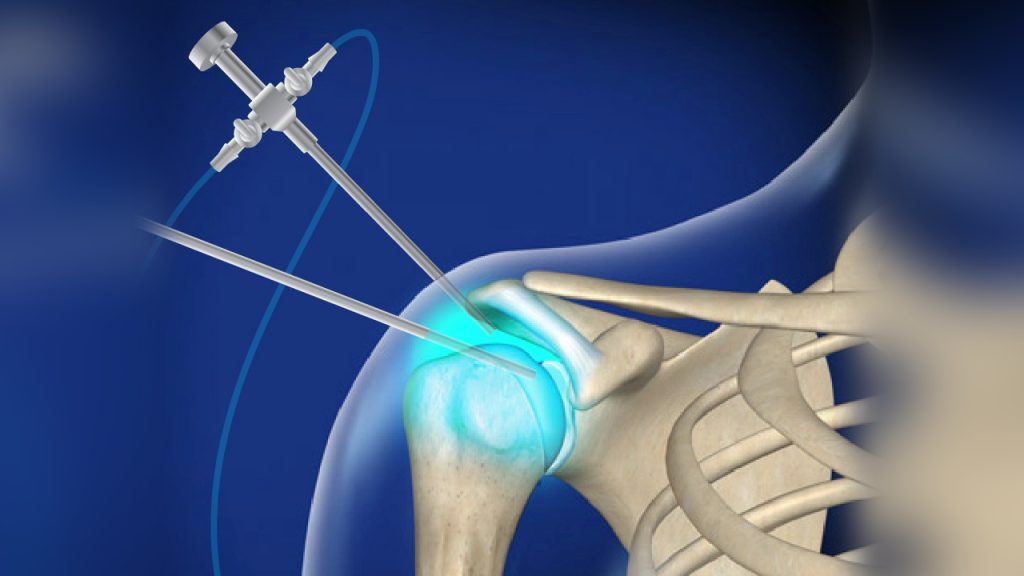Shoulder Arthroscopy In Nagpur

Shoulder Arthroscopy In Nagpur
Shoulder arthroscopy is a minimally invasive surgical procedure used to diagnose or treat a variety of shoulder conditions. During this procedure, an orthopedic surgeon uses a small camera (arthroscope) and tiny surgical instruments inserted through small incisions around the shoulder joint to view and repair damaged tissues, such as cartilage, tendons, and ligaments.
Shoulder arthroscopy is preferred for its ability to treat joint problems with smaller incisions, leading to less pain, a faster recovery, and minimal scarring compared to traditional open surgery. This advanced technique is commonly used for treating shoulder injuries, tears, arthritis, and other conditions that affect the shoulder’s mobility and function.
When Should You Consider Shoulder Arthroscopy?
Shoulder arthroscopy may be recommended if you experience:
- Chronic shoulder pain that limits your ability to move or perform daily tasks.
- Rotator cuff tears or damage to the tendons surrounding the shoulder.
- Frozen shoulder (adhesive capsulitis) that causes stiffness and pain.
- Shoulder impingement syndrome, where tendons are pinched during arm movement.
- Labral tears, which affect the cartilage that helps keep the shoulder joint stable.
- Arthritis or degenerative joint conditions causing pain and swelling in the shoulder.
- Shoulder instability or frequent dislocations that compromise joint function.
Why Choose Shoulder Arthroscopy?
There are many benefits to choosing shoulder arthroscopy over traditional open surgery:
- Minimally Invasive: The procedure requires only small incisions, typically less than a centimeter, which means less tissue disruption, less pain, and smaller scars.
- Faster Recovery: Since arthroscopy is minimally invasive, the recovery time is generally quicker compared to open surgeries.
- Reduced Risk of Infection: The smaller incisions reduce the risk of infection and other complications associated with larger, open surgeries.
- Accurate Diagnosis and Treatment: The arthroscope provides high-definition images of the inside of the joint, allowing for more precise diagnosis and treatment.
- Less Postoperative Pain: As a result of smaller incisions and less tissue trauma, patients typically experience less pain after surgery, and they can usually manage it with less medication.
What to Expect During Shoulder Arthroscopy
The process of undergoing shoulder arthroscopy generally follows these steps:
- Pre-Surgery Consultation: Your orthopedic surgeon will assess your medical history, perform a physical examination, and order imaging tests (like X-rays or MRI scans) to confirm the diagnosis.
- Anesthesia: Shoulder arthroscopy is typically performed under general anesthesia or regional anesthesia (numbing the arm). The anesthesia will ensure that you are comfortable and pain-free during the procedure.
- Small Incisions: The surgeon will make a few small incisions around the shoulder joint. A thin tube with a camera (arthroscope) is inserted to provide a view of the joint on a screen.
- Surgical Procedure: Using specialized instruments, the surgeon will perform the necessary repairs or removal of damaged tissue. This may include repairing tendons, removing bone spurs, or cleaning out the joint.
- Post-Operative Care: After the procedure, you’ll be monitored in a recovery room. Most patients can go home the same day, although some may need a short hospital stay if additional treatment is needed.
Recovery and Rehabilitation After Shoulder Arthroscopy
While shoulder arthroscopy is minimally invasive, recovery is still an important aspect of the process. The recovery timeline typically involves:
- Initial Recovery: You will likely need to wear a sling for a few days or weeks to support the shoulder while it heals. Pain and swelling can be managed with ice and prescribed medications.
- Physical Therapy: After the initial healing period, physical therapy will be essential to regain strength, mobility, and function in the shoulder. The therapist will guide you through exercises to restore movement and flexibility.
- Gradual Return to Activities: Most patients can return to light activities within 2-6 weeks, with more strenuous activities (such as sports or heavy lifting) resuming in 3-6 months, depending on the procedure and healing progress.
Benefits of Choosing Shoulder Arthroscopy
Here are the primary benefits of opting for shoulder arthroscopy:
- Minimized Pain and Recovery Time: The small incisions used during arthroscopy mean less trauma to surrounding tissues and a faster recovery compared to traditional shoulder surgery.
- Reduced Risk of Complications: Arthroscopy involves smaller incisions, leading to a lower risk of infection, scarring, and complications compared to open surgeries.
- Preservation of Joint Function: The goal of arthroscopy is to treat the underlying problem while preserving as much of the healthy tissue and joint function as possible.
- Quick Return to Daily Activities: Many patients experience a quicker return to their daily activities and work, with less time away from their routine.
Choosing the Right Shoulder Arthroscopy Surgeon
When considering shoulder arthroscopy, it’s crucial to select an experienced orthopedic surgeon who specializes in shoulder surgery. Here are a few tips for choosing the right surgeon:
- Experience and Specialization: Look for a surgeon who specializes in shoulder arthroscopy and has extensive experience performing the procedure.
- Board Certification: Ensure that the surgeon is board-certified in orthopedic surgery and has a good reputation in the medical community.
- Patient Reviews: Reading patient reviews and testimonials can help you get a sense of the surgeon’s skill, bedside manner, and overall care.
- Technology and Facilities: Choose a hospital or clinic that offers the latest technology and state-of-the-art surgical facilities to ensure the best outcomes.
Conclusion
Shoulder arthroscopy is a safe, effective, and minimally invasive solution for a variety of shoulder issues, from rotator cuff tears to arthritis and shoulder instability. With its numerous benefits, including reduced pain, faster recovery, and better outcomes, arthroscopy offers an ideal option for patients looking to relieve shoulder pain and restore function.
